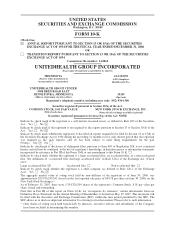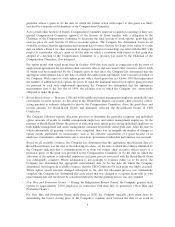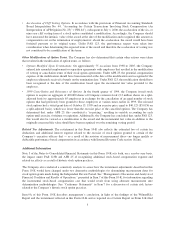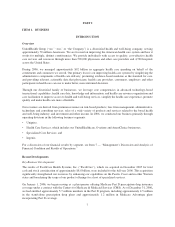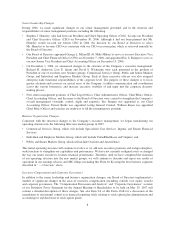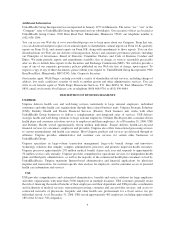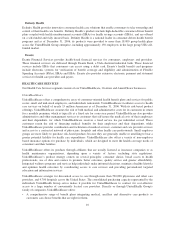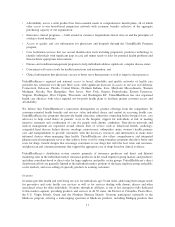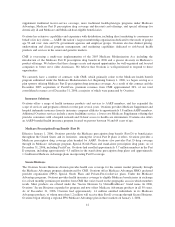United Healthcare 2006 Annual Report Download - page 7
Download and view the complete annual report
Please find page 7 of the 2006 United Healthcare annual report below. You can navigate through the pages in the report by either clicking on the pages listed below, or by using the keyword search tool below to find specific information within the annual report.•Acceleration of Cliff Vesting Options. In accordance with the provisions of Financial Accounting Standards
Board Interpretation No. 44, “Accounting for Certain Transactions Involving Stock Compensation (An
Interpretation of APB Opinion No. 25)” (“FIN 44”), subsequent to July 1, 2000, the acceleration of the six- or
nine-year cliff vesting term of a stock option constituted a modification. Accordingly, the Company should
have measured the intrinsic value of the award at the date of the modification and recognized this amount as
compensation cost on the termination of employment if, absent the acceleration, the award would have been
forfeited pursuant to its original terms. Under FAS 123, the performance targets were taken into
consideration when determining the expected term of the award and therefore the acceleration of vesting was
not considered to be a modification of the terms.
Other Modifications of Option Terms. The Company has also determined that certain other actions were taken
that resulted in the modification of option terms, as follows:
•Options Modified Upon Terminations. On approximately 75 occasions from 1998 to 2005, the Company
entered into amended employment or separation agreements with employees that resulted in the modification
of vesting or cancellation terms of their stock option agreements. Under APB 25, the potential compensation
expense of the modification should have been measured at the date of the modification and recognized if the
employee ultimately received a benefit on the termination date. Under FAS 123, the modification should have
been recognized at the date of the modification based upon the incremental fair value provided to the
employee.
•1999 Cancellation and Reissuance of Options. In the fourth quarter of 1999, the Company issued stock
options to acquire an aggregate of 400,000 shares of Company common stock (3.2 million shares on a split-
adjusted basis) to approximately 65 employees in exchange for the cancellation of an equal number of stock
options that had previously been granted to those employees at various times earlier in 1999. The reissued
stock options had a stated grant date of October 13, 1999 and an exercise price equal to $40.125 ($5.0156 on
a split-adjusted basis), which was lower than the exercise price of the cancelled options. The Company has
determined that, under APB 25, this constituted a “re-pricing,” resulting in variable accounting for each
option until exercise, forfeiture or expiration. Additionally, the Company has concluded that, under FAS 123,
this would also be viewed as a modification to the award and the incremental fair value in addition to the
originally measured fair value should have been recognized over the remaining vesting period.
Related Tax Adjustments. The restatement in this Form 10-K also reflects the estimated loss of certain tax
deductions and additional interest expense related to the exercise of stock options granted to certain of the
Company’s executive officers that — as a result of the revision of measurement dates—no longer qualify as
deductible performance-based compensation in accordance with Internal Revenue Code section 162(m).
Additional Information
Note 3 of the Notes to Consolidated Financial Statements in this Form 10-K sets forth, on a year-by-year basis,
the impact under FAS 123R and APB 25 of recognizing additional stock-based compensation expense and
related tax effects as a result of historic stock option practices.
The Company also conducted a sensitivity analysis to assess how the restatement adjustments described in this
Form 10-K would have changed under two alternative methodologies for determining measurement dates for
stock option grants made during the Independent Review Period. See “Management’s Discussion and Analysis of
Financial Condition and Results of Operations,” presented in Item 7 of this Form 10-K, for information regarding
the incremental stock-based compensation cost that would result from using alternate measurement date
determination methodologies. See “Cautionary Statements” in Item 7 for a discussion of certain risk factors
related to the Company’s historic stock option practices.
Item 9A of this Form 10-K describes management’s conclusion, in light of the findings of the WilmerHale
Report and the restatement reflected in this Form 10-K and as reported in a Current Report on Form 8-K filed
5

